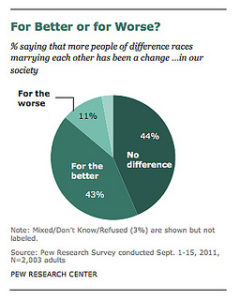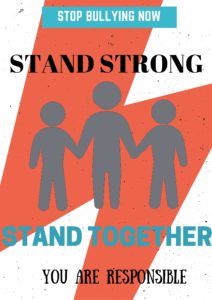Analyzing Interracial Families through analytical tools in Wahneema Lubiano’s piece, “Black Ladies, Welfare Queens and State Minstrels.”
The elite (white Anglo Saxon protestant male), manipulates] cultural narratives such as the ‘poverty-produced welfare queen and the affirmative action black lady not only perpetuating racism and sexism but to guarantee the continued unequal distribution of economic resources,” (Lubiano).
Narratives about interracial marriage are sewn throughout our culture. An ideological war is raging across our country and it is in large part because of these common narratives developed and kept over time.
The disconnect between reality and what the media portrays as ‘normal’ is extremely misleading. According to a Pew Research Study, the proportion of interracial marriage reached an all-time high in 2010. In that year, about 15 percent of all new marriages were interracial and 8.4 percent of all existing marriages were interracial.
But the television and film industry have not caught up to the reality of interracial families.
Interracial marriages are becoming more common but lack of interracial marriage represented in the media causes shock from many groups, the few times families are showcased in television, films or ads.
This Cheerio’s commercial, “Just Checking” caused a lot of outrage among certain citizens. The Cheerios ad featured a little girl, her white mother and her black father. The ad brought a rash of racists’ comments to YouTube, Facebook and Redditt including insensitive jokes and racial rants. (Sample quote: “If the dad was a stereotypical black, I don’t think they would have needed more than 2 actors for the commercial.)
Although, The Supreme Court struck down laws that banned interracial marriage way back in 1967, our ideological narratives still give that underlying story of these types of marriages to be outside of the ‘norm’ or ‘bad.’ The lack of interracial families in media can also stand for the media trying to hide it or pretend it doesn’t exist. The racial comments towards this ad shows how strong certain types of families become ingrained in our society and those outside of the ‘norm’ are criticized.
There are even certain narratives within certain interracial relationships. According to Bitch Magazine:
“A University of Florida study of blockbuster Hollywood films between 1967 and 2005 concluded that the media is stuck on specific portrayals of interracial relationships: in the movies sampled, 42 percent of female characters in such pairings were victims of violence. “While white women in interracial relationships came across as either morally corrupt or socially inept or as victims of physical or sexual abuse, women of color who become involved with white men were often presented as erotic, exotic and possessing exceptional talents.” And although it is statistically more likely for black men to ‘marry out’ of their race, the movie industry seems less keen on interracial couples with black men. According to this informal accumulation of movies with interracial couples, there are twice as many films featuring white men with black women than black men with white women.”
Lubiano is fearful that certain narratives can shape and destroy the way we view other people. In Lubiano’s piece certain narratives—they maybe the ‘sapphire’, the ‘strong black woman’ or ‘the welfare queen’, categorize black women. An individual cannot rid themselves of these labels when they are ingrained into our culture. Lubiano says that, “These pictures through their timing and their spatial arrangement, were signposts for a successful set of narrative constructions, activations, and deployments by the state—including what people are reminded of when certain categories, phrases, and abstract figures with political resonance are evoked,” (Black Ladies and Welfare Queens). The state uses narratives of interracial couples (or purposefully leaves them out) in order to control what is ‘acceptable’ for an American family and what is not.
Understanding how and why the state manipulates narratives of family will help us recognize the line between real and cultural politics. These narratives mask the failures of the state and place blame on the individual for not living up to the idealized (and often, unattainable standards) given to them.




Recent Comments